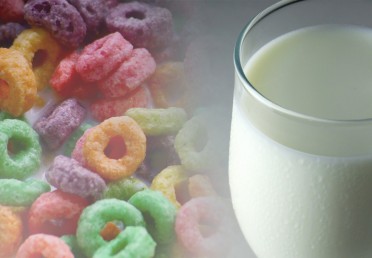Glass of milk after sugary cereal may prevent cavities
 Washing down sugary breakfast cereal with milk after eating reduces plaque acid levels and may prevent damage to tooth enamel that leads to cavities, according to new research at the University of Illinois at Chicago College of Dentistry.
Washing down sugary breakfast cereal with milk after eating reduces plaque acid levels and may prevent damage to tooth enamel that leads to cavities, according to new research at the University of Illinois at Chicago College of Dentistry.
Dry, ready-to-eat, sugar-added cereals combine refined sugar and starch. When those carbohydrates are consumed, bacteria in the dental plaque on tooth surfaces produce acids, says Christine Wu, professor of pediatric dentistry and director of cariology, who served as principal investigator of the study.
The research is published in the July issue of the Journal of the American Dental Association.
Reports have shown that eating carbohydrates four times daily, or in quantities greater than 60 grams per person per day, increases the risk of cavities.
The new study, performed by Wu’s former graduate student Shilpa Naval, involved 20 adults eating 20 grams of dry Froot Loops cereal, then drinking different beverages — whole milk, 100 percent apple juice, or tap water.
Plaque pH, or acidity, was measured with a touch microelectrode between the premolar teeth before eating; at two and five minutes after eating; and then two to 30 minutes after drinking a liquid.
The pH in plaque dropped rapidly after consuming cereal alone, and remained acidic at pH 5.83 at 30 minutes. A pH below 7 is acidic; a pH greater than 7 is basic. Pure water has a pH close to 7.
Participants who drank milk after eating sugary cereal showed the highest pH rise, from 5.75 to 6.48 at 30 minutes. Those who drank apple juice remained at pH 5.84 at 30 minutes, while water raised the pH to 6.02.
Fruit juices are considered healthy food choices, but the added sugar can be a risk to dental health, Wu said.
“Our study results show that only milk was able to reduce acidity of dental plaque resulting from consuming sugary Froot Loops,” said Naval, who is currently a fellow at the Centers for Disease Control and Prevention in Atlanta. “We believe that milk helped mitigate the damaging effect of fermentable carbohydrate and overcome the previously lowered plaque pH.”
Milk, with a pH ranging from 6.4 to 6.7, is considered to be a functional food that fights cavities because it promotes tooth remineralization and inhibits the growth of plaque, Wu said.
Wu says most consumers think that since milk is considered to be cavity-fighting, acid production by plaque bacteria can be minimized by mixing it with cereal. However, in an unpublished study in her lab, it was discovered that the combination of Froot Loops and milk became syrupy. Eating cereal combined with milk lowered plaque pH to levels similar to that obtained after rinsing with a 10 percent sugar solution.
Eating sugar-added cereal with milk, followed by drinking fruit juice is thus a highly cavity-causing combination, Wu said.
Diet plays an important role in oral health, Wu said. Studies of food intake and cavities have focused mainly on the sugar, or carbohydrate, content. Fewer studies have looked at how combinations of food, and the order in which they are eaten, may help fight cavities.
“Results from a previous study suggested that the last food item consumed exerts the greatest influence on subsequent plaque pH,” she said. For example, eating cheese after a sugary meal reduces acid production, and consumers can modify their diet in such a way as to prevent the cavity-causing effects of sugary foods.”
“If understood and implemented properly, food sequencing can be used as a public health educational tool to maintain and preserve good oral health,” said Naval.
Other contributors included Drs. Anne Koerber, Larry Salzmann, Indru Punwani, and Bradford Johnson, all of the dentistry faculty at UIC. The research was supported by the college’s pediatric dentistry department.
